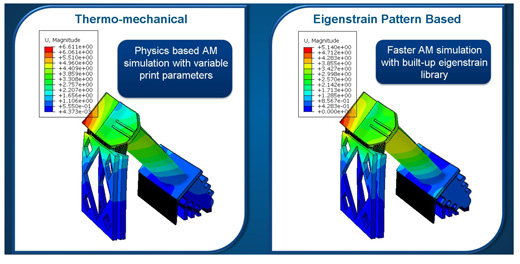Additive manufacturing simulations are key in assessing a finished part’s quality. The physics behind the manufacturing process can be accurately recreated in software platforms enabling end to end digitalization – predicting residual stresses, voids, cracks, and so on, factors which will be crucial in the service life of a part. In an article by SIMULIA‘s Subham Sett and Jing Bi, recently published in InTech Magazine (a publication of the International Society of Automation), the authors describe the process of optimizing simulations with additive manufacturing, and conclude:
- Most digital tools address some of the critical additive production challenges but rely on others to complete the entire process—causing loss in production.
- An organization needs a model-based approach that integrates design, materials, manufacturing, and production to successfully evolve additive from the lab to a production environment.
- An unbiased public benchmark is crucial to building trust in the additive community.
Here’s an excerpt from the article:
Do I have to acquire another specialized simulation software, develop another set of techniques, maintain libraries for individual parts and machines? What if the process parameters change? What if a set tool path for polymer extrusion does not get me the right part strength? Do I go back to the drawing board? One way to address this concern is to be rigorous in the management of the AM simulation chain: machines, processes, and materials. If not planned with care, chances for drowning in the data lake are high. There is a better way to address this issue, though, by providing researchers and analysts with a general-purpose simulation framework designed from the ground up to handle any machine, any process, and any material. In other words, a framework agnostic of the process, but driven at a deeper level by the science of energy and material handling. Energy decides how the material evolves during the process. For metal powder, the laser sources fuse the powder, and as it solidifies, the as-built material properties decide the part strength and quality. For polymer extrusion, the energy source to fuse the pellets is the extrusion process. Each process inputs this energy as a series of events that are distributed in space and time, predetermined as part of the manufacturing process.
Read the full article to learn more.
Want to learn more about Dassault Systèmes SIMULIA’s full portfolio of integrated applications for additive manufacturing that connect across multiple disciplines—design, manufacturing and simulation? The 3DEXPERIENCE platform provides a rich set of applications, here.

